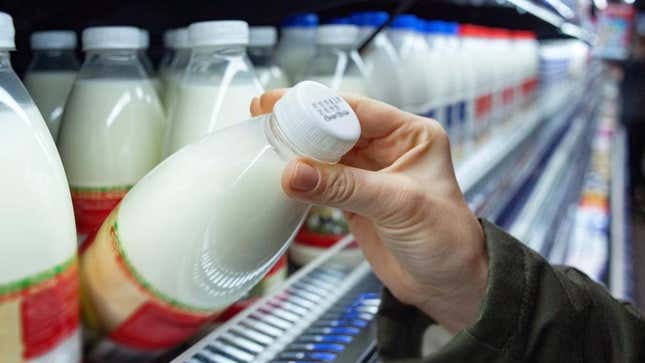
“Sell by.” “Use by.” “Best by.” Each term means something different, and each one causes us to perform different calculations in our heads to determine whether a food item should stay in the fridge or get tossed out. Thankfully, Food Dive reports that a number of researchers and various companies are working on developing new technology that could soon bring that confusion to an end.
Before getting into the details of the advancements that could save us all some refrigerator space and potentially prevent food waste, here’s a brief refresher of what the current system looks like.
How food expiration labels work
It’s important to note that the current “freshness” dates used on many food products actually don’t mean much in terms of food safety. In 2019, the Food and Drug Administration began supporting food industry efforts to standardize use of the term “Best if Used By” on packaged food. This label, again, doesn’t correlate with food safety, but rather the freshness of the food and ostensibly its quality. From there, consumers can decide for themselves whether to keep or toss.
Outside of baby formula, which is required to have a “Use By” date, the range of these date labels is generally determined by the manufacturer, who is not required to get approval from the FDA for its date labels or specify how the date was determined. Kevin Smith, Senior Advisor for Food Safety in the FDA’s Center for Food Safety and Applied Nutrition, notes that determining food quality and freshness is not an exact science. Smith suggests taking other cues from the product beyond its date label: Has it noticeably changed in color, consistency, or texture? Is there any odor emanating from the product that wasn’t present before? And so on.
Date label standards also vary by state and might not take into account the transportation or storage conditions of the food, which means it’s really up to us, our senses, and our personal judgment to determine what we consume.
Food freshness sensors in development
To combat this confusion and the waste that comes with it, researchers from the biosensors lab at Clarkson University have developed a sensor that changes color when food starts to degrade.
The label is paper and placed inside packaging so it doesn’t actually touch the food item. However, foods like meat and fish naturally produce higher levels of a chemical compound called hypoxanthine as they begin to spoil. Those increased levels trigger the paper label to change color and indicate that the food is going bad.
At Southern Methodist University, scientists have created a pH sensor that is designed to be low-cost, easy to mass-produce, and very small—2 millimeters by 10 millimeters, to be exact. These qualities are crucial in making the sensor more appealing to manufacturers who may be hesitant to make what they see as unnecessary and potentially costly changes to their operations.
The sensor detects the level of hydrogen ions in a food product, which affect the pH levels. The sensor then sends that information to servers along the supply chain using radiofrequency identification, or RFID, technology. This means manufacturers could monitor a food’s quality throughout its journey to the grocery store.
Similar to what the university scientists are working on, a Swedish and U.S.–based company called Vitsab has developed what it’s calling the Freshtag. This tag uses food-safe adhesive to attach to a label and uses red and green indicators, like a stoplight, to show whether a food is safe to eat or not, based on food safe temperatures. The same company is also working on an ink-based technology that would be part of a product’s barcode. Once the ink fades, that indicates it is not at the correct temperature and has gone bad.
Other early-stage technology being used or researched around the world include a food label in Sweden that attaches to the plastic film of a meat package. When meat degrades, it releases an organic compound which causes the label’s ink to change color. And in the United Kingdom, a company called Mimica has developed a packaging insert that contains a temperature-sensitive hydrogel which changes as a product ages.
The bottom line will ultimately determine when these food sensors reach consumers. Bringing these ideas out of a lab and into a food manufacturer’s large-scale production line can be costly; that’s why many developers have chosen to focus on sensors that can be incorporated into existing packaging rather than create a new add-on that might hinder the process.
Reducing waste in our supply chain has many long-term benefits, and these sensors might eventually become an integral part of that. While we wait, though, we still have the good ol’ smell test.